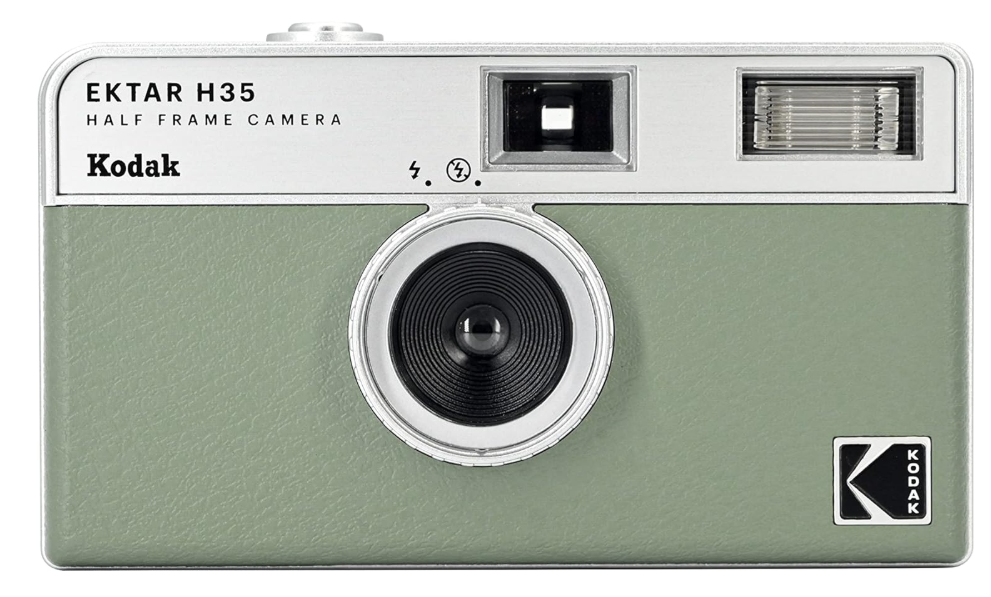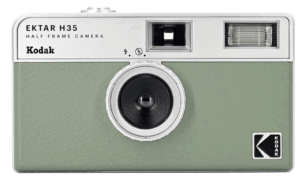Film photography offers a timeless, hands-on approach to capturing images, and choosing the right beginner-friendly camera can make all the difference in your learning experience.
The best film cameras for beginners combine simplicity, reliability, and the right balance of manual and automatic features to help you master the fundamentals without feeling overwhelmed.
From fully manual classics like the Pentax K1000, which teach the core principles of exposure, to versatile icons like the Canon AE-1 with both manual and auto modes, and compact half-frame options like the Kodak Ektar H35 for budget-conscious shooting, there’s a camera to suit every learning style.
Whether you’re drawn to the solid feel of an SLR, the precision of a rangefinder, or the ease of a point-and-shoot, these beginner-friendly film cameras open the door to creativity while making the journey into analog photography both accessible and enjoyable.
Best Film Cameras for Beginners
1) Pentax K1000 Manual Focus SLR Film Camera
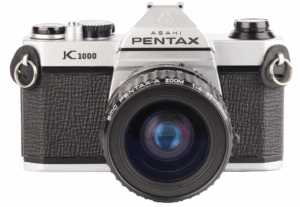
The Pentax K1000 35mm SLR is one of the Best Film Cameras for Beginners, it features; Completely mechanical operation for reliability and independence from batteries, Simple three-control design; ideal for beginners learning manual photography among other incredible features.
The Pentax K1000 35mm SLR is an enduring classic in the world of photography, celebrated as one of the most popular and longest-lived film cameras ever made. Entirely mechanical, it operates without a battery, relying solely on manual controls for complete creative freedom; though an A76 cell battery is required to power its built-in light meter.
Designed with remarkable simplicity, the K1000 offers just three shooting controls; aperture, shutter speed, and focus; making it exceptionally beginner-friendly while still beloved by experienced photographers. Film speed is set when loading, and the meter and camera are always active for instant shooting without fumbling with power switches.
This stripped-down approach forces you to think more about your composition and exposure, rather than navigating menus or modes, which is why it’s a staple recommendation from photography teachers and instructors worldwide. Its robust build and straightforward operation make it a timeless tool for learning and mastering the art of film photography.
Pros:
-
Completely mechanical operation for reliability and independence from batteries
-
Simple three-control design; ideal for beginners learning manual photography
-
Built-in light meter for easy exposure guidance
-
Always-on meter and shutter for instant shooting
-
Recommended by photography educators for training and skill development
-
Durable build quality with a long-lasting reputation
Cons:
-
Requires a separate A76 battery to operate the light meter
2) Vintage Canon AE-1 35mm SLR Camera

The Vintage Canon AE-1 is a legendary 35mm SLR camera that blends classic design with innovative features, making it one of the most iconic film cameras ever produced. Featuring an electronically controlled AE (Automatic Exposure) system and a focal plane shutter, it delivers precise, consistent exposures with ease.
The AE-1 is compatible with Canon FD series interchangeable lenses, offering full aperture metering and AE coupling, while also accommodating Canon FL series lenses with stopped-down metering. Standard lenses include the Canon FD 55mm f/1.2 S.S.C, FD 50mm f/1.4 S.S.C, and FD 50mm f/1.8 S.C., ensuring exceptional optical performance. Built with a Canon Breech-Lock mount, it supports FD, FL, and R lenses for versatility.
The fixed eye-level pentaprism viewfinder provides an impressive field of view; 93.5% vertical and 96% horizontal coverage; offering an accurate preview of your shot. Inside the viewfinder, you’ll find an aperture scale with a meter needle and stopped-down metering, which doubles as a battery charge level check, adding to its intuitive usability. This combination of functionality and durability has made the AE-1 a timeless favorite among photography enthusiasts.
Pros:
-
Electronically controlled AE system for accurate automatic exposure
-
Wide compatibility with Canon FD, FL, and R series lenses
-
High-quality standard lens options with exceptional sharpness
-
Bright and accurate fixed pentaprism viewfinder with large coverage area
-
Intuitive viewfinder display with aperture scale and battery check
-
Durable, well-built design with classic vintage appeal
Cons:
-
Requires batteries for shutter and exposure functions
3) NIKON F100 35mm SLR Camera
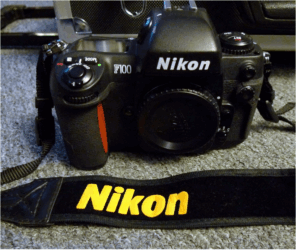
The Nikon F100 is a high-performance 35mm SLR camera body designed for serious photographers, positioned just below the flagship F5 in Nikon’s professional lineup and above the N90 in capabilities. Engineered with a strong yet lightweight magnesium alloy body, the F100 offers the perfect balance of durability and portability, making it a favorite for pros who need a compact yet powerful tool.
Its built-in motor drive allows shooting speeds of up to 4.5 frames per second, ideal for capturing fast-moving subjects with precision. The advanced 10-Segment 3D Matrix Metering system ensures accurate exposures in diverse lighting conditions, complemented by Center-Weighted and 5-Area metering modes for greater flexibility.
The 5-Area Autofocus system, paired with Dynamic Autofocus tracking, delivers sharp, reliable focus even on moving subjects. Combining robust build quality, professional-level performance, and intuitive controls, the Nikon F100 remains a top choice for film photography enthusiasts seeking speed, accuracy, and versatility.
Pros:
-
Professional-grade build with lightweight magnesium alloy body
-
Compact size without sacrificing performance features
-
Fast continuous shooting at up to 4.5 frames per second
-
Advanced 10-Segment 3D Matrix Metering for accurate exposures
-
Multiple metering modes for flexibility in different lighting situations
-
5-Area Autofocus with Dynamic tracking for moving subjects
Cons:
-
Heavier than consumer-grade film cameras
4) YASHICA Electro 35 Film Camera
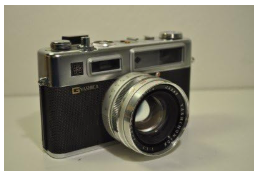
The Yashica Electro 35 is a classic 35mm rangefinder camera is one of the Best Film Cameras for Beginners, it features; Comes with a premium 2-piece leather case for protection and style, Includes the sharp and versatile Yashinon-DX 45mm lens among other incredible features.
The Yashica Electro 35 is a classic 35mm rangefinder camera that blends vintage charm with practical functionality, making it a favorite among film photography enthusiasts. Designed for color film shooting, it comes complete with a 2-piece leather case for stylish protection and portability.
At its heart is the sharp Yashinon-DX 45mm lens, renowned for delivering crisp, vibrant images with beautiful rendering. This model also includes an additional Japanese-made lens, expanding creative possibilities right out of the box.
The Electro 35 offers manual exposure control, giving photographers full authority over their shots, while its rangefinder focusing system ensures precise composition. Built with Yashica’s signature durability and paired with a timeless aesthetic, this camera is as much a collectible piece as it is a reliable tool for everyday shooting.
Pros:
-
Comes with a premium 2-piece leather case for protection and style
-
Includes the sharp and versatile Yashinon-DX 45mm lens
-
Additional Japanese-made lens expands creative options
-
Manual exposure control for full shooting flexibility
-
Durable, well-built vintage design
-
Rangefinder system allows for accurate focusing
Cons:
-
Fully manual exposure may challenge beginners
5) KODAK EKTAR H35 Half Frame Film Camera
The Kodak Ektar H35 Half Frame Film Camera is one of the Best Film Cameras for Beginners, it features; Doubles the number of photos per roll for cost-effective shooting, Compact, lightweight design for easy daily carry among other incredible features.
The Kodak Ektar H35 Half Frame Film Camera is a fun, beginner-friendly option that makes film photography more economical and creative. Designed to maximize your rolls, it delivers twice as many shots per roll; a 36-exposure film can produce around 72 half-frame images; making it ideal for storytelling, diptychs, or simply getting more value from your film.
Its compact, lightweight, pocket-sized design makes it easy to carry daily, so you’re always ready to capture moments on the go. The camera features a simple point-and-shoot operation, making it perfect for analog newcomers, while the built-in flash; activated by rotating the silver ring around the lens; ensures you can shoot in both day and night, indoors or outdoors.
Available in five stylish colors; off-white, black, brown, sage, and sand; the Kodak Ektar H35 combines practical features with a neat, natural aesthetic for photographers who want simplicity and charm in one package.
Pros:
-
Doubles the number of photos per roll for cost-effective shooting
-
Compact, lightweight design for easy daily carry
-
Simple operation; ideal for beginners and casual users
-
Built-in flash for versatile day and night photography
-
Available in five attractive, stylish colors
Cons:
-
Half-frame format produces smaller negatives than standard 35mm
Factors to Consider When Choosing the Best Film Cameras for Beginners
1. Ease of Use
For beginners, a film camera should be straightforward to operate without overwhelming menus or complex settings. Models like the Pentax K1000 or Kodak Ektar H35 stand out because they focus on essential controls; aperture, shutter speed, and focus; helping new photographers learn the basics without distraction. Cameras with simple point-and-shoot functionality are great for those who want to start shooting immediately, while slightly more advanced models offer a gentle learning curve for those ready to experiment.
2. Manual vs. Automatic Controls
The level of control you want over your photography will influence your choice. Fully manual cameras, such as the Pentax K1000, encourage learning the fundamentals of exposure and composition, making them ideal for photography students. On the other hand, cameras like the Canon AE-1 offer both manual and automatic exposure modes, giving beginners the flexibility to ease into manual shooting while still having automated assistance when needed.
3. Lens Compatibility and Availability
A good beginner film camera should have access to a wide range of affordable, quality lenses. Systems like the Nikon F100 and Canon AE-1 accept numerous lenses from their respective mounts, allowing photographers to upgrade or experiment without buying a new body. Beginners benefit from starting with a standard prime lens for versatility, then expanding their collection as skills and interests grow.
4. Build Quality and Portability
Durability is essential, especially for new photographers who may be carrying their cameras everywhere. Sturdy bodies, such as the Nikon F100’s magnesium alloy frame or the Pentax K1000’s metal construction, can withstand daily use. Meanwhile, lighter, more compact options like the Kodak Ektar H35 or Yashica Electro 35 are easier to carry, making them excellent for casual shooting and travel.
5. Viewfinder and Focusing System
A bright, clear viewfinder helps beginners compose shots accurately and learn framing. For example, the Canon AE-1 offers a fixed eye-level pentaprism with useful exposure information, while rangefinders like the Yashica Electro 35 provide precise manual focusing through a coupled rangefinder system. Autofocus systems, such as the Nikon F100’s 5-area AF with tracking, can help new photographers capture sharp images of moving subjects.
6. Exposure Metering
Accurate metering is crucial for well-exposed photos. Beginners will appreciate reliable built-in light meters, like the 10-Segment 3D Matrix Meter in the Nikon F100 or the match-needle meter in the Pentax K1000. These systems guide exposure settings, helping new photographers understand how light affects their images while reducing the risk of under- or over-exposure.
7. Film Format and Shooting Economy
The type of film and shooting economy should also be considered. Standard 35mm film is widely available and perfect for beginners. Half-frame cameras like the Kodak Ektar H35 offer twice the number of shots per roll, making them cost-effective for practice. Beginners should choose a format that balances image quality, cost, and availability of film processing services.
8. Price and Availability
Affordability is a key factor for beginners who may not want to invest heavily at first. Popular starter models like the Pentax K1000, Canon AE-1, and Kodak Ektar H35 are widely available on the used market at reasonable prices. This makes it easier for beginners to start shooting without a large upfront cost, while still getting a reliable and capable camera.
